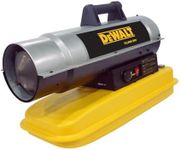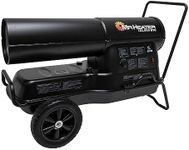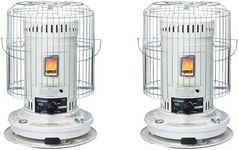Buying Guide for the Best Kerosene Shop Heaters
When choosing a kerosene shop heater, it's important to consider several key specifications to ensure you select the best model for your needs. Kerosene heaters are a popular choice for providing warmth in workshops, garages, and other large spaces due to their efficiency and portability. Understanding the key specs will help you make an informed decision and ensure you get a heater that meets your requirements for safety, performance, and convenience.Heating Capacity (BTU)Heating capacity, measured in British Thermal Units (BTU), indicates the amount of heat the heater can produce. This spec is crucial because it determines how effectively the heater can warm up your space. Heaters with lower BTU ratings (10,000-30,000 BTU) are suitable for smaller areas or supplemental heating, while those with higher BTU ratings (30,000-100,000+ BTU) are better for larger spaces or primary heating. To pick the right one, consider the size of the area you need to heat and choose a heater with a BTU rating that matches your space's requirements.
Fuel Tank CapacityThe fuel tank capacity indicates how much kerosene the heater can hold. This is important because it affects how long the heater can run before needing a refill. Smaller tanks (1-2 gallons) will require more frequent refills, which might be inconvenient for long-term use. Larger tanks (3-5+ gallons) allow for extended operation without interruption. Choose a heater with a fuel tank capacity that aligns with your usage patterns and how often you are willing to refill the tank.
Run TimeRun time refers to how long the heater can operate on a full tank of kerosene. This spec is important for planning how long you can expect the heater to run without needing a refill. Shorter run times (4-8 hours) might be sufficient for occasional use, while longer run times (10-15+ hours) are better for continuous or overnight heating. Consider your typical usage duration and select a heater with a run time that meets your needs.
Safety FeaturesSafety features are critical in ensuring the safe operation of your kerosene heater. Common safety features include automatic shut-off, tip-over protection, and overheat protection. These features help prevent accidents and ensure the heater operates safely. When choosing a heater, prioritize models with comprehensive safety features, especially if you plan to use the heater in a busy or unattended environment.
PortabilityPortability refers to how easy it is to move the heater from one location to another. This is important if you need to use the heater in different areas or store it when not in use. Features that enhance portability include wheels, handles, and a compact design. If you need to move the heater frequently, look for a model that is lightweight and has convenient portability features.
Noise LevelNoise level indicates how loud the heater is during operation. This is important if you are sensitive to noise or if you will be using the heater in a space where quiet is preferred. Heaters with lower noise levels are more suitable for environments where noise can be disruptive. Consider your tolerance for noise and the environment in which you will be using the heater when selecting a model.




















